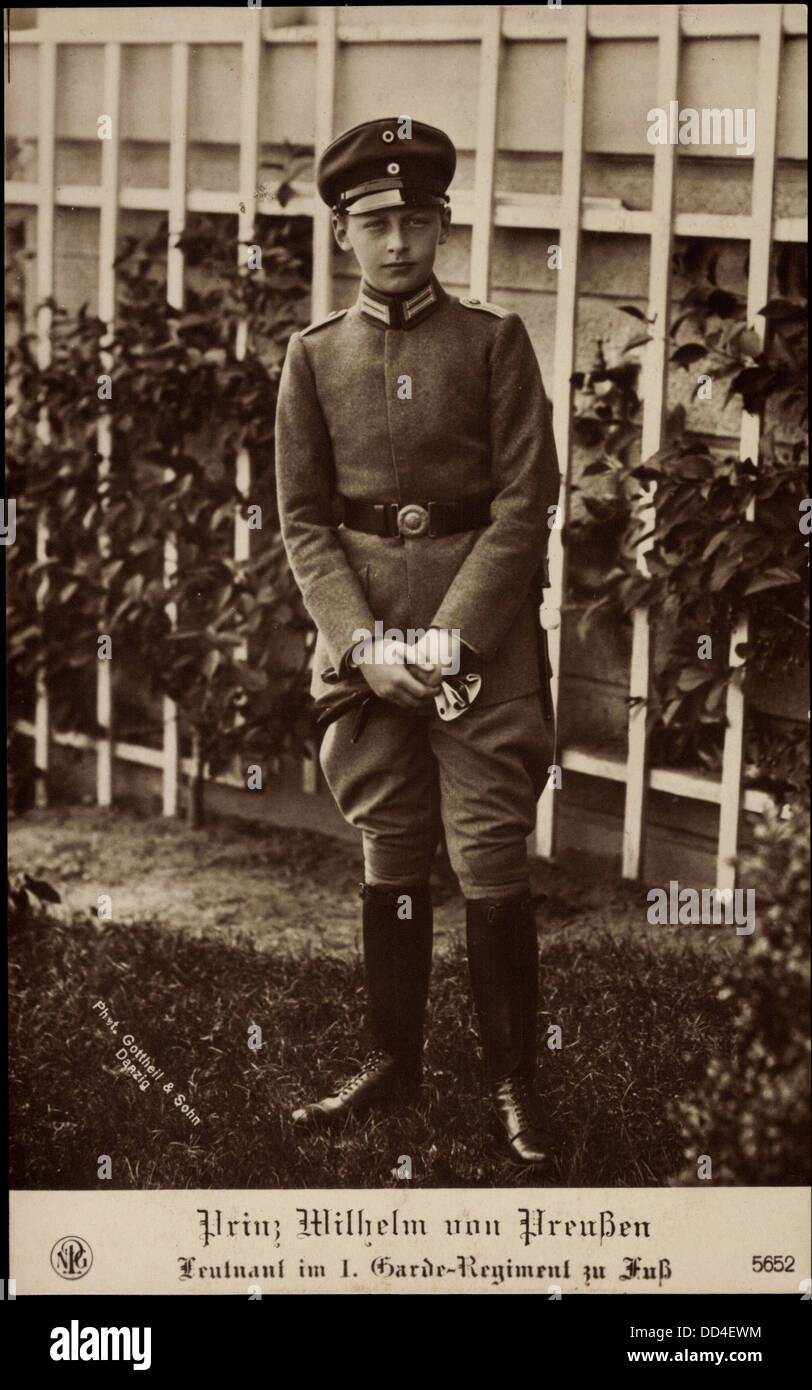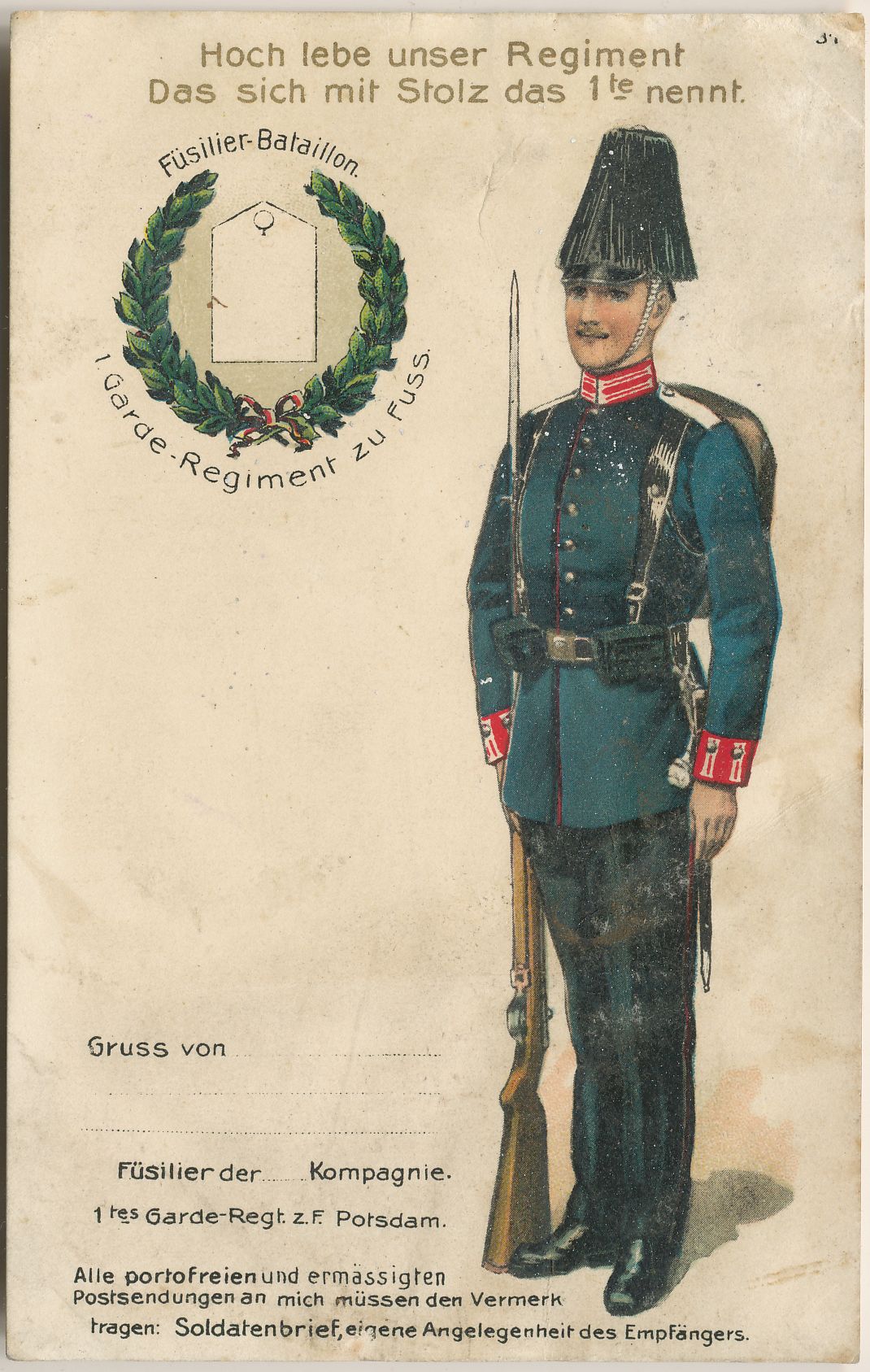
» PRUSSIA MITRE ENLISTED MAN ERSTE GARDE REGIMENT ZU FUß BATAILLON NR III FRIEDRICH der
Category:1. Garde-Regiment zu Fuß From Wikimedia Commons, the free media repository Subcategories This category has the following 3 subcategories, out of 3 total. F Flags of the Prussian 1st Regiment of Foot Guards (6 F) M Monument to 1. Garde-Regiment zu Fuß in Saint-Privat (1899) (1 F) S Sealing stamps of 1. Garde-Regiment zu Fuß (17 F)

Ak Prinz Wilhelm von Preußen, Leutnant im 1. Garde Regiment zu Fuß, NPG 5652 Stock Photo Alamy
Garde-Infanterie-Division) was a unit of the Prussian (and later) Imperial German Army and was stationed in Berlin . Lineage The division was created on September 5, 1818 when the guards brigades, which had been created in 1813 and were assigned to various commands, were grouped into a single formation. [1]

Truppenfahne 1. GardeRegiment zu Fuss by PHAFFM on DeviantArt
The 1st Foot Guard Regiment ( German: 1. Garde-Regiment zu Fuß) was an infantry regiment of the Royal Prussian Army formed in 1806 after Napoleon defeated Prussia in the Battle of Jena-Auerstedt.

Detail of the painting showing the Erste Garde Regiment zu Fuss in formation. The standard
Das 1. Garde-Regiment zu Fuß war eine Infanterie-Einheit der preußischen Armee. Es entstand im Jahr 1806 aus den Resten zerschlagener Garde-zu-Fuß-Einheiten nach der Niederlage Preußens gegen Napoleon in der Doppelschlacht bei Jena und Auerstedt. Seit seiner Aufstelleung war es das Leibregiment der Könige von Preußen.

German; 1st Garde Regiment zu Fuss, Crown Prince Wihelm & Grenadier, Parade Dress, 1896
Ein Garderegiment ist ein militärischer Truppenteil, der zur Garde gehört, und dadurch in besonderer Beziehung zum Staatsoberhaupt steht. Im Gegensatz dazu nennt man die übrigen Regimenter, die nicht zur Garde, sondern zur sog. „Linie" zählen, Linienregimenter . Ein Regiment besteht bei der Infanterie zumeist aus mehreren Bataillonen . Preußen

Band XVIII 58. Preußen. 1. GardeRegiment zu Fuß. 1912. Preußen, Militärgeschichte, Streitkräfte
The corps rose to a strength of 43 volunteers, and on 17 December 1813 attached itself to the volunteer detachment of the Fusilier battalion of the Prussian 1. Garde-Regiment zu Fuß (1st Foot Guards), in whose ranks it took part in the 1814 winter campaign in France.

An infantryman from the Erste Garde Regiment zu Fuss. Army uniform, Imperial army, German army
Garde-Regiment zu Fuß) was an infantry regiment of the Royal Prussian Army formed in 1806 after Napoleon defeated Prussia in the Battle of Jena-Auerstedt. It was formed by combining all previous Foot Guard Regiments and was, from its inception, the bodyguard-regiment of Kings of Prussia.
AKedOLTWNIo0sqW0O8h8G8sBoNaQiczafyj2y4GbbXp7=s900ckc0x00ffffffnorj
2. Garde-Regiment zu Fuss. The 2.Garde-Regiment zu Fuss was a late addition to the Prussian order of battle, being created during the Summer Armistice of 1813.. The new regiment was built up from a cadre formed by the Normal-Infanterie-Bataillon (which had been originally created as a 'model' infantry unit to demonstrate the new organisation, tactics and uniforms of the infantry arm of the.

Band X 58 Wurtenberg Garde zu Fuss 1808 Uniformes militares, Guerras napoleónicas
Garde-Regiment zu Fuß (Gemälde von Carl Röchling, 1894) Die 1. Garde-Division, für die Dauer des mobilen Verhältnisses auch als 1. Garde-Infanterie-Division bezeichnet, war ein Großverband der Preußischen Armee . Inhaltsverzeichnis 1 Geschichte 1.1 Gliederung 1.1.1 Friedensgliederung 1914 1.1.2 Kriegsgliederung bei Mobilmachung 1914

Review of the Erste Garde Regiment zu Fuss by Kaiser Wilhelm II in front of the palace in
Garde-Regiment zu Fuß war ein Infanterie verband der Preußischen Armee, dessen Tradition bis zum Regiment Kurfürst zu Fuß von 1675 zurückreicht. Inhaltsverzeichnis 1 Geschichte 2 Entwicklung des Regiments 2.1 Vorläufer 2.2 Aufstellung 2.3 Aufbau 3 Uniformen 3.1 1807 3.2 1824 3.3 1842 3.4 Feldgraue Uniform 4 Standorte 5 Fahnen des Regiments

Happiness is a Large Busch Prussian Foot Guard Regiments in 1813 (15mm AB Figures) Jemima
Garde-Regiment zu Fuß) was an infantry regiment of the Royal Prussian Army formed in 1806. The regiment considered itself the most noble regiment of Christendom ( vornehmstes Regiment der Christenheit ). The regiment was disbanded in 1919, with the Infantry Regiment 9 Potsdam of the new Reichsheer bearing its tradition.

German; 1st GardeRegiment zu Fuß, 1st Battalion, Colours, c.1890 Regiment, Battalion, German
Imperial German Army, 1. Garde Regiment zu Fuss; Associated places Germany, pre 1945; Associated subjects german army, infantry pre 1919, guards regiments; Our collections information. We have over a million object records online, and we are adding to this all the time. Our records are never finished.

1847 Uniform for a soldier in the Erste Garde Regiment zu Fuss. German army, Imperial army
Garde-Reg. zu Fuß 1. Garderegiment zu Fuß Potsdam "Das vornehmste Regiment der zivilisierten Christenheit" Das 1. Garderegiment zu Fuß ging im wesentlichen aus zwei Vorgängerregimentern hervor: dem Regiment des Königs, bzw. Bataillon Grenadiergarde Nr. 6 und dem Regiment Garde Nr. 15. 1677-1806

Pin on 16881918 1st GARDE REGIMENT ZU FUSS
1. Garde-Regiment zu Fuß.- Personalangaben der Offiziere, Sanitätsoffiziere und oberen Beamten Mehr anzeigen Weniger anzeigen. zu Verbundenen Objekten Alle ausklappen. Alle einklappen. Angaben zum Objekt Archivaliensignatur. Bundesarchiv, BArch PH 10-II/928. Mehr anzeigen Weniger.

1. Garde Regiment zu Fuß — online kaufen Auktionskatalog "64 Auktion" vom 15.02.2020 Foto
Garde-Regiment zu Fuß) was a regiment in the Prussian Army prior to and during the First World War. Established in 1897, it was part of the 5th Guards Infantry Brigade and the 2nd Guards Division. During peacetime the regiment was garrisoned in Spandau .

1. Garde zu Fuss, finally nailed it.... Germany Imperial Rick (Research) Lundstrom Forum for
Kompanie des neuen Regiments Garde bilden, später 1. Garde-Regiment zu Fuß. Schlachten 1689 ging das 1. Bataillon mit fünf Kompanien an den Rhein, 1691 nach Flandern, 1691/1692 nach Brabant, wo es bei Gent, Ath und Namur kämpfte. Das II. Bataillon zog 1691/1692 nach Ungarn und nahm an den Schlachten von Slankamen, Peterwardein und Zenta.